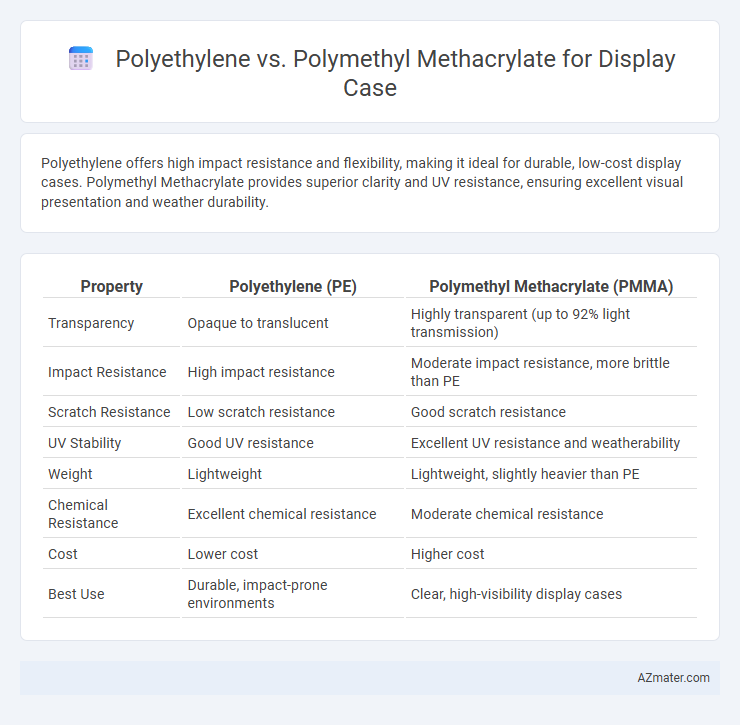Polyethylene offers high impact resistance and flexibility, making it ideal for durable, low-cost display cases. Polymethyl Methacrylate provides superior clarity and UV resistance, ensuring excellent visual presentation and weather durability.
Table of Comparison
| Property | Polyethylene (PE) | Polymethyl Methacrylate (PMMA) |
|---|---|---|
| Transparency | Opaque to translucent | Highly transparent (up to 92% light transmission) |
| Impact Resistance | High impact resistance | Moderate impact resistance, more brittle than PE |
| Scratch Resistance | Low scratch resistance | Good scratch resistance |
| UV Stability | Good UV resistance | Excellent UV resistance and weatherability |
| Weight | Lightweight | Lightweight, slightly heavier than PE |
| Chemical Resistance | Excellent chemical resistance | Moderate chemical resistance |
| Cost | Lower cost | Higher cost |
| Best Use | Durable, impact-prone environments | Clear, high-visibility display cases |
Introduction to Display Case Materials
Polyethylene and Polymethyl Methacrylate (PMMA) are popular materials for display cases due to their durability and optical properties. Polyethylene offers excellent impact resistance and flexibility, making it ideal for protective display cases in high-traffic environments. PMMA, known for its superior clarity and scratch resistance, provides a premium appearance for showcasing items with enhanced visual appeal.
What is Polyethylene?
Polyethylene is a lightweight, durable thermoplastic polymer widely used in display cases due to its excellent impact resistance and moisture barrier properties. This material offers high chemical resistance and flexibility, making it suitable for environments requiring robust protection against physical damage. Polyethylene's cost-effectiveness and recyclability also contribute to its popularity compared to Polymethyl Methacrylate, which typically provides higher transparency but less impact resistance.
What is Polymethyl Methacrylate (PMMA)?
Polymethyl Methacrylate (PMMA) is a transparent thermoplastic commonly known as acrylic or plexiglass, prized for its clarity and durability in display case applications. It offers high light transmittance of approximately 92%, superior UV resistance, and excellent weatherability compared to polyethylene. PMMA's scratch resistance and rigidity make it ideal for protective display cases requiring clear visibility and long-term performance.
Durability Comparison: Polyethylene vs PMMA
Polyethylene offers superior impact resistance and flexibility, making it highly durable for display cases prone to physical stress and accidental drops. Polymethyl Methacrylate (PMMA) provides excellent scratch resistance and clarity but is more brittle, increasing its vulnerability to cracking under high impact. For long-term durability, polyethylene outperforms PMMA in resistance to impact and environmental wear, while PMMA excels in maintaining optical clarity.
Optical Clarity and Transparency
Polymethyl Methacrylate (PMMA) offers superior optical clarity and transparency compared to Polyethylene (PE), with light transmittance rates exceeding 90%, making it ideal for display cases requiring clear, crisp visibility. Polyethylene generally has lower transparency and can appear hazy or opaque, limiting its use where visual appeal and light transmission are critical. The high gloss and UV resistance of PMMA also contribute to its preference in applications demanding long-lasting optical performance.
Impact Resistance and Protection
Polyethylene offers superior impact resistance compared to Polymethyl Methacrylate (PMMA), making it ideal for display cases requiring enhanced protection against drops and accidental hits. PMMA, while providing excellent clarity and UV resistance, is more prone to cracking under high-impact stress, which can compromise the safety of valuable items inside the case. For environments where durability and impact protection are critical, polyethylene is the preferred material due to its toughness and resilience against mechanical shock.
UV Resistance and Long-Term Preservation
Polymethyl Methacrylate (PMMA) offers superior UV resistance compared to Polyethylene, making it ideal for display cases exposed to sunlight or strong artificial lighting. PMMA maintains clarity and structural integrity over long-term use, preventing yellowing and brittleness that commonly affect Polyethylene under UV exposure. For long-term preservation of valuable items, PMMA provides enhanced durability and protection against photo-degradation, ensuring displays remain pristine and visually appealing.
Maintenance and Cleaning Requirements
Polyethylene offers superior resistance to chemicals and impact, making it easier to clean and maintain without risk of scratching or discoloration, ideal for high-traffic or industrial display cases. Polymethyl Methacrylate (PMMA), while providing excellent optical clarity and scratch resistance, requires gentle, non-abrasive cleaning agents to prevent surface damage, increasing maintenance effort. Choosing polyethylene reduces long-term upkeep with washing using mild detergents, whereas polymethyl methacrylate demands careful handling to preserve its transparent finish.
Cost Analysis: Polyethylene vs PMMA
Polyethylene offers a lower initial cost compared to Polymethyl Methacrylate (PMMA), making it a budget-friendly option for display cases with basic durability needs. PMMA, while more expensive upfront, provides superior clarity and scratch resistance, which can reduce long-term maintenance and replacement expenses. Evaluating total cost of ownership, PMMA may present better value for premium displays requiring enhanced aesthetics and durability.
Best Applications for Each Material
Polyethylene is ideal for display cases requiring impact resistance and flexibility, such as protective covers for heavy or frequently handled items, due to its durable and shock-absorbing properties. Polymethyl Methacrylate (PMMA), also known as acrylic, excels in applications demanding clarity, UV resistance, and aesthetic appeal, making it perfect for showcasing valuable collectibles or retail displays with high visual emphasis. Selecting polyethylene suits rugged, utilitarian cases, while PMMA is preferred for transparent, visually striking cases that enhance product visibility.

Infographic: Polyethylene vs Polymethyl Methacrylate for Display Case
 azmater.com
azmater.com